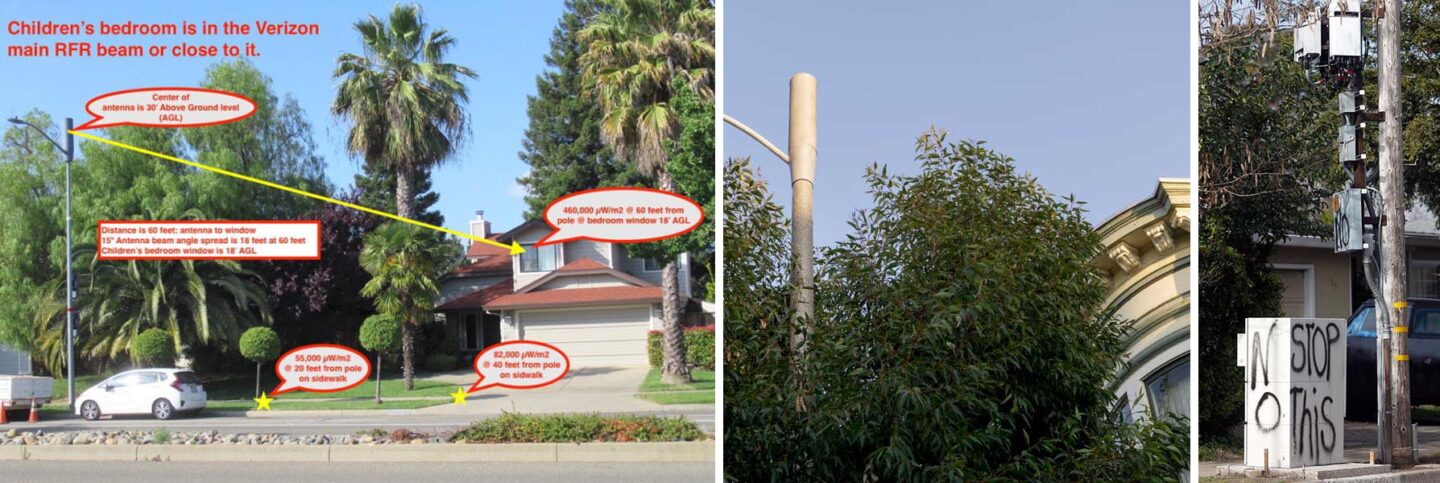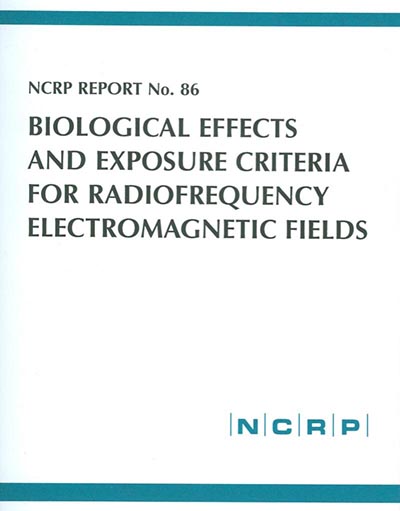Human Exposure to Radiofrequency Electromagnetic Microwave Radiation (RF-EMR): Guidelines for Cellular Antenna Sites
- Source → https://www.fcc.gov/sites/default/files/human_exposure_to_radio_frequency_fields_-_guidelines_for_cellular_antenna_sites.pdf
- See [ S4WT: Annotations, below . . . S4WT = Scientists For Wired Technology → https://scientists4wiredtech.com/]
Primary antennas for transmitting wireless telephone service, including cellular and Personal Communications Service (PCS), are usually located outdoors on towers, water tanks and other elevated structures like rooftops and sides of buildings. The combination of antenna towers and associated electronic equipment is referred to as a “cellular or PCS cell site” or “base station.”
[ S4WT: or, better yet, a Wireless Telecommunications Facility (WTF) ]
Cellular or PCS cell site towers WTFs are typically 50-200 feet high. Antennas are usually arranged in groups of three per cell with one antenna in each group used to transmit signals to mobile units, and the other two antennas used to receive signals from mobile units.
[ S4WT: there are usually three 120° cells per WTF, so, typically, at least nine antennas per WTF ]
At a cell site, the total radio frequency (RF) power that can be transmitted from each transmitting antenna depends on the number of radio channels (transmitters/amplifiers) that have been authorized by the Federal Communications Commission (FCC) and the power of each transmitter/amplifier. The FCC permits an effective radiated power (ERP) of up to 500 watts per channel. Typically, most cellular or PCS cell sites in urban and suburban areas operate at an ERP of 100 watts per channel or less.
An ERP of 100 watts corresponds to an actual radiated power of 5-10 watts,
[ S4WT: Really? How does that happen? ]
. . . depending on the type of antenna used. In urban areas, cell sites commonly emit an ERP of 10 watts per channel or less.
[ S4WT: Let’s see . . . the FCC’s power output estimate just dropped by 90% . . . hmmm. ]
For PCS cell sites, even lower ERPs are typical.
[ S4WT: Really? How does that happen? . . . and why why should anyone care about the FCC’s low-ball estimate of “typical”? Is there any reason to trust the FCC or the Wireless industry about these matters? None that we can see. ]
As with all forms of electromagnetic energy, the power density from a cellular or PCS transmitter rapidly decreases as distance from the antenna increases.
[ S4WT: And, conversely, the power density from a cellular or PCS transmitter rapidly increases as distance from the antenna decreases — that is the fatal problem with so-called “small” Wireless Telecommunications Facilities (sWTFs) constructed in the public rights-of-way: as the distance decreases from 2,500 Feet to 25 feet, the power output increases about 10,000 times — in theory. Actual measurements, however, tell a much, much worse story . . . ]
Problems With So-Called “small” Wireless Telecommunications Facilities (sWTFs)
sWTFs are falsely branded. They are 25 million times more powerful than Macro Cell Towers, once you consider the metric that matters — the intensities of the toxic pollutant (RF/MW radiation) that reaches second- and third-story bedrooms:
What Really Matters: Excessive Effective Radiated Power (ERP)
That Results in RF Microwave Radiation Intensities in 2nd-Story+ Bedrooms
| Cell Tower | Vertical Distance Off Ground | Horizontal Distance Away | Power in bedroom (2nd-story+) |
|---|---|---|---|
| small cell | 35 feet | 60 feet | 50,000 avg. radiation units |
| Macro cell | 200 feet | 2,500 feet | 0.002 avg. radiation units |
Conclusion: 50,000 µW/m² from a so-called “small” cell is 25 million times more powerful than 0.002 µW/m² (-85 dBm) from a Macro cell —
Note: -85 dBm is a signal strength which provides 5 Bars of telecommunications service on a cell phone (source: link to The Truth About 4G/5G in Sacramento )

Sacramento, CA: 60 feet from home → children immediately sickened (© Windheim EMF Solutions) | San Francisco, CA: 10 feet from home → brain tumor diagnosed in three months | Santa Rosa, CA: 20 feet from home → home sold at 23% discount ($150,000+ loss in property value)
Consequently, normal ground-level exposure is much less than the exposure that might be encountered if one were very close to the antenna and in its main transmitted beam.
[ S4WT: So now consider the plight of those sleeping in second- and third-story bedrooms with sWTFS constructed in front of their homes in the public rights-of-way ]
Measurements made near typical cellular and PCS cell sites have shown that ground-level power densities are well below the exposure limits recommended by RF/microwave safety standards used by the FCC.
[ S4WT: So what? Compliance with FCC RF-EMR exposure Guideline does not and cannot insure public safety.]
Guidelines
In 1996, the FCC adopted updated guidelines for evaluating human exposure to RF fields from fixed transmitting antennas such as those used for cellular and PCS cell sites.
The FCC’s guidelines are identical to those recommended by the National Council on Radiation Protection and Measurements (NCRP), a non-profit corporation chartered by Congress to develop information and recommendations concerning radiation protection.
[ S4WT: So what? Just because it matches some federally-funded private organization’s best guess, it does not amount to anything that can be considered scientific, or protective of the human environment. We read the 1986 paper; Chapter 17 (the final chapter) pretty much ignores what was written in Chapters 1-16. The author of chapter 17 was some “undisclosed government guy.” — a common trick. ]
The FCC’s guidelines also resemble the 1992 guidelines recommended by the Institute of Electrical and Electronics Engineers (IEEE), a non-profit technical and professional engineering society, and endorsed by the American National Standards Institute (ANSI), a nonprofit, privately-funded membership organization that coordinates development of voluntary national standards in the United States.
[ S4WT: So what? A bunch of engineers dreamed up a complicated way to bamboozle the public and make money for the last 24 years . . . that does not make the FCC RF-EMR Guideline scientific or protective of the human environment. ]
The FCC’s guidelines also resemble the 1992 guidelines recommended by the Institute of Electrical and Electronics Engineers (IEEE), a non-profit technical and professional engineering society, and endorsed by the American National Standards Institute (ANSI), a nonprofit, privately-funded membership organization that coordinates development of voluntary national standards in the United States.
In the case of cellular and PCS cell site transmitters, the FCC’s RF exposure guidelines recommend a maximum permissible exposure level to the general public of approximately 580 microwatts per square centimeter.
The FCC’s guidelines also resemble the 1992 guidelines recommended by the Institute of Electrical and Electronics Engineers (IEEE), a non-profit technical and professional engineering society, and endorsed by the American National Standards Institute (ANSI), a nonprofit, privately-funded membership organization that coordinates development of voluntary national standards in the United States.
[ S4WT: Not exactly . . . see https://scientists4wiredtech.com/regulation/rf-microwave-exposure-guidelines/ and https://scientists4wiredtech.com/wireless-industry-false-claims-that-regulatory-compliance-means-safety/, . . . 580 µW/cm² is 5,800,000 µW/m² which is the FCC limit for frequencies close to 850 MHz — the FCC RF-EMR Guideline is frequency-specific, up to 1500 MHz.]
This limit is many times greater than RF levels typically found near the base of cellular or PCS cell site towers or in the vicinity of other, lower-powered cell site transmitters.
[ S4WT: So what? Negative health consequences and biological effects from RF-EMR have been established at -37 dBm by the BioIntiative Report (or around 58 µW/m² — which is 100,000 times lower than 5,800,000 µW/m² ]
Calculations corresponding to a “worst-case” situation (all transmitters operating simultaneously and continuously at the maximum licensed power) show that, in order to be exposed to RF levels near the FCC’s guidelines, an individual would essentially have to remain in the main transmitting beam and within a few feet of the antenna for several minutes or longer. Thus, the possibility that a member of the general public could be exposed to RF levels in excess of the FCC guidelines is extremely remote.
[ S4WT: So what? See above. ]
When cellular and PCS antennas are mounted on rooftops, RF emissions could exceed higher than desirable guideline levels on the rooftop itself, even though rooftop antennas usually operate at lower power levels than free-standing power antennas. Such levels might become an issue for maintenance or other personnel working on the rooftop.
[ S4WT: Of course, RF emissions that exceed higher than desirable
guidelinebiologically-based levels (RF-EMR at 58 µW/m² or higher) would be a hazard for all of the people living nearby, particlularly those living on the floors closest to the antennas — see the plight of San Francisco resident, Cherly Lea Hogan ]
Exposures exceeding the guidelines levels, however, are only likely to be encountered very close to, and directly in front of, the antennas. In such cases, precautions such as time limits can avoid exposure in excess of the guidelines.
[ S4WT: That’s right . . . Time of exposure is critically important and mostly ignored by the FCC . . . what about people who sleep below these antennas every night? What is the solution for these people getting in excess of 58 µW/m² — all night long? ]
Individuals living or working within the building are not at risk.
[ S4WT: Wh-a-a-a-t? The preceding is a false statement based on the 10,000+ peer-reviewed, Daubert-rule admissible scientific studies— established science that easily refutes that FCC whopper. ]
Consumer Help Center
For more information on consumer issues, visit the FCC’s Consumer Help Center at https://www.fcc.gov/consumers.
Last Reviewed by the FCC on 10/15/19; last annotated on 8/21/2020.
